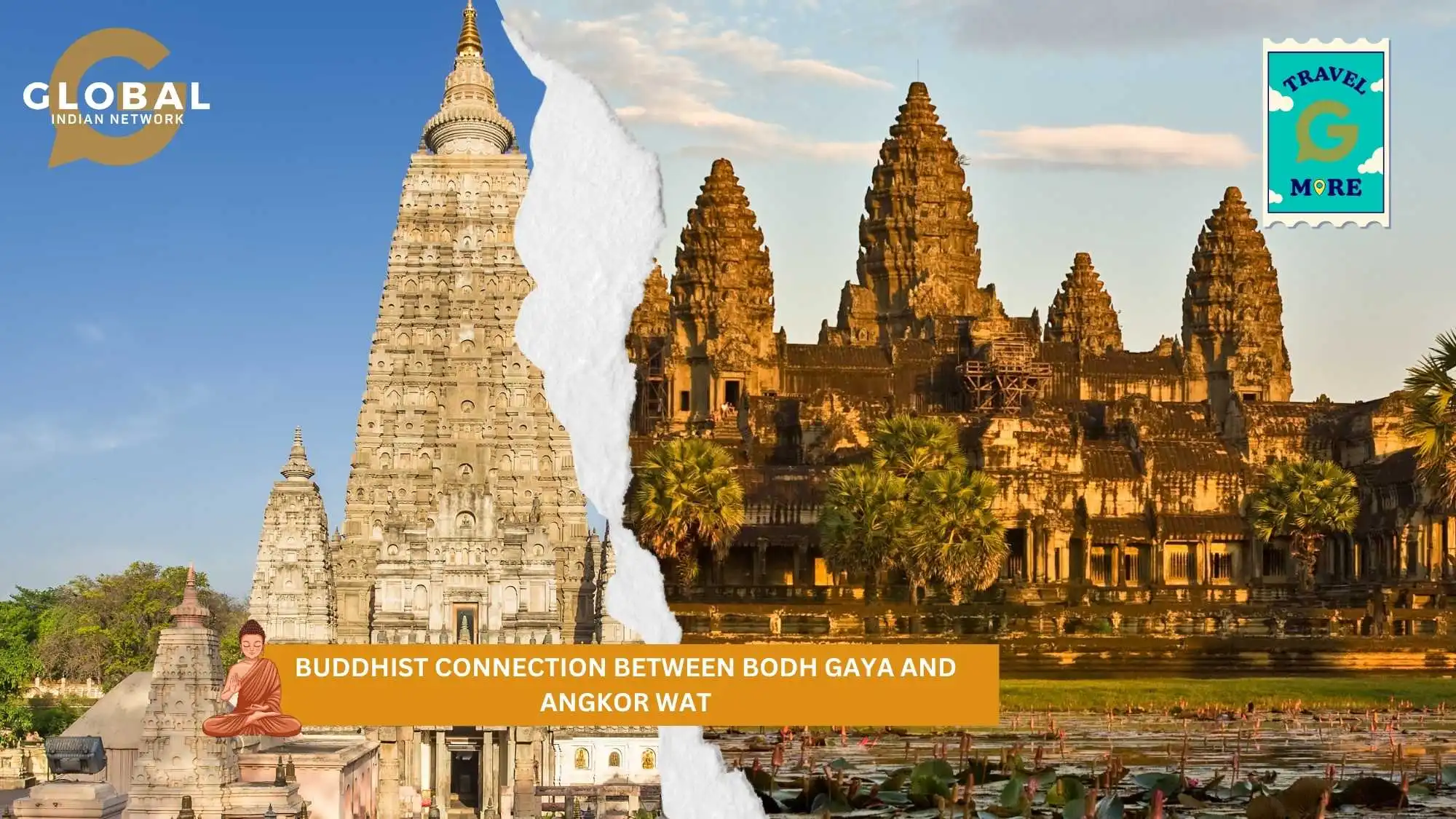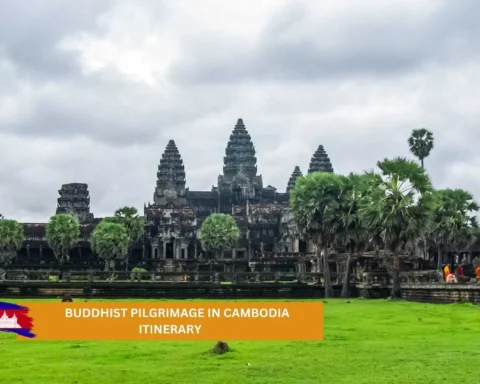The Buddhist connection between Bodh Gaya and Angkor Wat illustrates how faith, art, and culture are carried from one country to another. Bodh Gaya in India is the site of the Buddha’s enlightenment and the location where he began teaching his followers. Then, many years later, Angkor Wat in Cambodia, initially a Hindu temple, became a location for Buddhist worship. This transition occurred as Buddhism spread from India to additional locations in Asia over centuries. This connection between Bodh Gaya and Angkor Wat illustrates how religion can travel, expand, and ultimately influence the development and transformation of the beliefs and traditions of people in disparate locations over time.
Table of Contents
Bodh Gaya: The Beginning of Buddhism
Bodh Gaya is one of the most sacred and renowned places in the world for Buddhists. It is located in the Indian state of Bihar. It is the place where a young prince, Siddhartha Gautama, sat under a tree, meditated deeply, and ultimately became the Buddha, or “the enlightened one.” The special tree is known as the Bodhi Tree, and the moment he achieved enlightenment under it (more than 2,500 years ago) is considered the inception of Buddhism.
Siddhartha had been searching for answers to questions about life, suffering, and peace. Before achieving enlightenment, he gave up his royal life and meditated for many years, trying various methods to find the truth. When Siddhartha arrived in Bodh Gaya, after his practice, he discovered what he was searching for, and his enlightenment revealed to him that suffering ends with mindfulness, compassion, and understanding. The moment Siddhartha became the Buddha in Bodh Gaya in India, it became the foundation of the teachings of Buddhism that support the beliefs and practices of millions around the world today.
After becoming the Buddha, he traveled throughout India to teach his ideas. His message of being good and moderate, of peacefulness, and that there was a way to end suffering began to gain traction. It extended to places like Sri Lanka, Thailand, Myanmar, and Cambodia. Bodh Gaya began to become popular as a pilgrimage destination with the expansion of Buddhism, and Southeast Asian monks, especially those from Cambodia, began to travel to Bodh Gaya to learn about the Buddha’s teachings and worship at the sacred site. This spiritual journey across regions helped form the Buddhist connection between Bodh Gaya and Angkor Wat.
Over the centuries, that association grew stronger. The teachings and values first put forth in Bodh Gaya influenced Cambodian kings and temple builders and ultimately led Angkor Wat to become a Buddhist temple. Buddhist connections between Bodh Gaya and Angkor Wat illustrate the impact of one sacred site in India on the dissemination of Buddhism as the faith and culture changed to interact with another civilization. Today, Bodh Gaya is still a peaceful site for teaching and reflection. It continues to positively influence naturally kind people from around the world and remains a mechanism for demonstrating how Buddhism connects individuals in time and space.

Buddhist Connection Between Bodh Gaya and Angkor Wat
This Buddhist connection between Bodh Gaya and Angkor Wat reveals a path of belief, art, and culture that journeyed from India and influenced the spirituality of Southeast Asia. While they are many thousands of kilometers apart, they share a long history of Buddhism and exchange.
Located in Bihar, India, Bodh Gaya is one of the most sacred sites for Buddhists. It is the site where Siddhartha Gautama meditated and became the Buddha under the Bodhi Tree over 2,500 years ago. This moment marks the beginning of Buddhism, which provided the world with a way of wisdom, mindfulness, and compassion. For centuries, the teachings of the Buddhist project, which drew on original Sinhalese culture, would have a lasting influence, taking root and growing in places such as Sri Lanka, Thailand, Myanmar, and Cambodia.
When Buddhism was eventually introduced to Cambodia, it began to influence and shape the already existing religious beliefs, including the development of new forms of art and architecture. One of the most impactful manifestations of this influence is Angkor Wat, a monumental temple complex built by King Suryavarman II honoring the god Vishnu early in the 12th century. Over time, Angkor Wat specifically changed or was repurposed; Angkor Wat gradually became a Buddhist site by the end of the 12th century, especially during the rule of King Jayavarman VII, who championed and practiced this Mahayana form of Buddhism.
Jayavarman VII played a significant role in promoting Buddhism in his kingdom across its domains. He created many temples in veneration of the Buddha, including temples today known as Bayon, Ta Prohm, and Preah Khan. Angkor Wat evolved into a Buddhist temple, reflecting the increasing influence of Buddhist beliefs in the region.
The Buddhist connection between Bodh Gaya and Angkor Wat is evident in the way Cambodian monks and scholars traveled to India, especially Bodh Gaya, to study Buddhist teachings. Many monks and scholars brought back not only religious teachings but also stylistic origins. The temple complex, built in Cambodia, was noticeable for its Indian origin, as evident in specific carvings of the Buddha, lotus flowers, and depictions of Buddhist stories.
Angkor Wat today is tangible evidence of this transformation. While originally a Hindu temple, it is now one of the most significant Buddhist pilgrimage sites in Southeast Asia and remains a sacred place for prayer and meditation for Cambodian Buddhists and visitors worldwide.
Angkor Wat’s Shift from Hinduism to Buddhism
Angkor Wat in Cambodia was originally constructed for King Suryavarman II in the early 12th century. This massive temple complex was intended to be a Hindu temple and was dedicated to the god Vishnu, making it one of the grandest temple complexes at that time. The carvings, towers, and layout all followed Hindu religious themes.
By the end of the 12th century, changes were made to Angkor Wat. Under King Jayavarman VII, Angkor Wat was slowly converted into a Buddhist temple. Jayavarman VII was a devotee of Mahāyāna Buddhism, which promotes the belief that all beings can achieve enlightenment and leads to compassion for all beings.
Jayavarman VII believed in a Bodhisattva, or one who intentionally delays their own enlightenment so they can help others find the path as well. He saw himself in this way and promoted Buddhist values throughout his kingdom and built many Buddhist temples, such as Bayon, Ta Prohm, and Preah Khan, that had cultural significance and means of Buddhist art.
The transition of Angkor Wat from a Hindu temple to a Buddhist temple reflects the close Buddhist connection between Bodh Gaya and Angkor Wat. Bodh Gaya is the location of the Buddha’s enlightenment; thus, Bodh Gaya became a very influential site for rulers, such as Jayavarman VII, who wished to emulate the path of the Buddha. This connection extended beyond the temples of Cambodia; it was deeply rooted in their religious life, studies, and beliefs as a people.
Conclusion
The Buddhist connection between Bodh Gaya and Angkor Wat is an excellent reminder of the way faith moves through the ages and across boundaries. The story began with the Buddha’s enlightenment under a tree in Bodh Gaya and grew into a wave of spirituality that reached the heart of Cambodia, embodied at Angkor Wat. Today, both are UNESCO World Heritage Sites and attract millions of visitors seeking a connection to Buddhism’s deep roots.

FAQs
Why is Angkor Wat important to Buddhism?
The temple was dedicated to Buddhism because the king’s wife, Indradevi, was a devout Mahayana Buddhist and urged him to convert. Angkor Wat was, therefore, also repurposed into a Buddhist site, with many of the Hindu sculptures replaced by Buddhist artworks.
How does Buddhism influence Cambodia?
Buddhism profoundly shapes how Cambodians view themselves, their values, customs, and lifestyle, contributing to the continuity of this ancient faith in a modern context. Religion is a key foundation of Cambodia’s identity, which is embodied in the Kingdom of Cambodia’s motto: “Nation, Religion, King.” Buddhism has been declared the state religion.
What is the spiritual significance of Angkor Wat?
Many visiting Angkor Wat often report feeling calm, more present, and experiencing a sense of spiritual clarity. This can be associated with the temple being an energy field with its own “energy” that is capable of clearing suppressed negative energies we hold on to, giving us physical, emotional and spiritual well-being.









